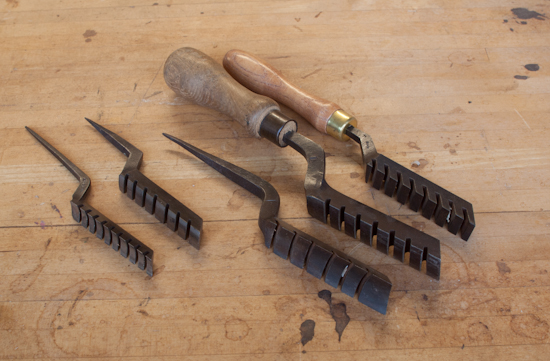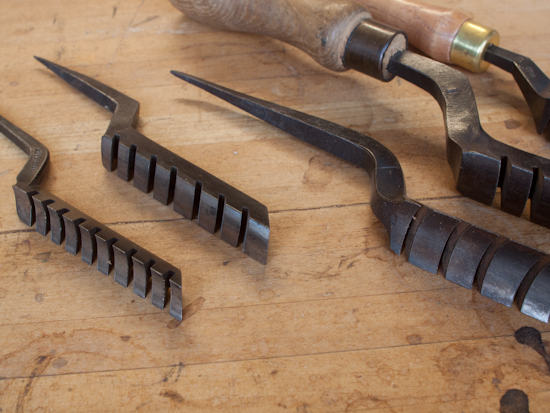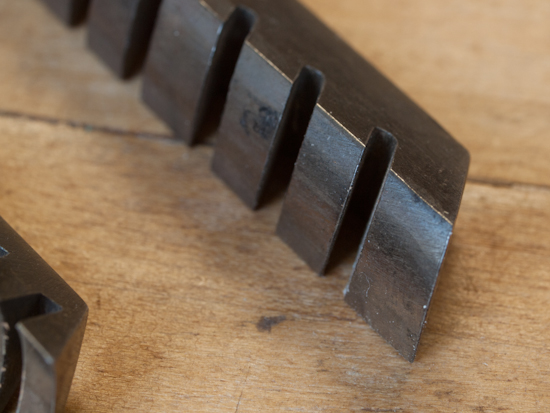 The pictures are of a small set of Mathieson cabinetmaker's floats that I purchased a few years ago. Available in a bunch of sizes to match standard hollow and round profiles, these were offered by Alex Mathieson & Son, the giant Glasgow tool makers, from the 1840's to I think around 1880. The pictures are of a small set of Mathieson cabinetmaker's floats that I purchased a few years ago. Available in a bunch of sizes to match standard hollow and round profiles, these were offered by Alex Mathieson & Son, the giant Glasgow tool makers, from the 1840's to I think around 1880.
While very rare, which is partly a function of the short time they were offered for sale, and partly because very few people bought them, the seemed the perfect antidote to how to work the last bit of a stopped molding. I also thought they might have some general cabinetmaking application as the Mathieson catalog does call them "Cabinetmaker's Floats".
Except that they don't work.
 I mean that they really don't work. Of the half dozen floats I have, none has any significant wear on them and the teeth of the float have no relief angle. So then you go over a board, nothing digs in and cuts. I could not get them to cut for squat. I am willing to entertain the idea that the user needed to sharpen the float by either adding relief or rolling on some sort of burr. Of the former notion, that would be really hard to do. There are a lot of teeth and no clearance for sharpening. Of the latter notion, the steel is hard, and there is no evidence that anyone even tried. Also, in any case, most tools sold usually have enough grinding on them so that they sort of work. These floats didn't work at all. I mean that they really don't work. Of the half dozen floats I have, none has any significant wear on them and the teeth of the float have no relief angle. So then you go over a board, nothing digs in and cuts. I could not get them to cut for squat. I am willing to entertain the idea that the user needed to sharpen the float by either adding relief or rolling on some sort of burr. Of the former notion, that would be really hard to do. There are a lot of teeth and no clearance for sharpening. Of the latter notion, the steel is hard, and there is no evidence that anyone even tried. Also, in any case, most tools sold usually have enough grinding on them so that they sort of work. These floats didn't work at all.
This might account for their rarity.
Now for the second part of the blog title. We like to think that the Victorian woodworker used series of molding planes to work all their moldings on a job, working in an airy, well lit workshop. While this might have been true for workshops in rural areas, and for high end shops, in most places moldings were things you bought pre-made in lengths from a lumber yard, just like today. And from the 1840's on (actually a little earlier in some cases) the moldings were machine made on early shapers.
As a modern day seller of router bits I can tell you that everyone these days uses carbide bits and both routers and shapers spin incredibly fast so that you get a smooth surface. In the 19th century this wasn't the case. The bits would be steel, and the speed of rotation nowhere as fast as today. Consequently you ended up with a molding with regularly spaced rises and falls. This problem gets even worse as the cutters dull - which happens pretty quickly.
So what do you do about it?
 Here is my theory, I have no contemporary evidence backing this up and would welcome some documentation. All I can say is that practical testing of my theory bears me out. If you take an uneven machine made molding, with the hills and valleys of a too slow or dull cutter and work a multi-tooth float with no relief over it, the float cuts. It evens out the hills and valleys and you get something that looks like it came from a molding plane. I think this is exactly what the Mathieson cabinetmaker's floats were for. And they were available from the early days of machine made moldings, where the uneven surface of the machine wasn't acceptable to only a few decades later, when the machines were better and customers also got used to machine made moldings. Here is my theory, I have no contemporary evidence backing this up and would welcome some documentation. All I can say is that practical testing of my theory bears me out. If you take an uneven machine made molding, with the hills and valleys of a too slow or dull cutter and work a multi-tooth float with no relief over it, the float cuts. It evens out the hills and valleys and you get something that looks like it came from a molding plane. I think this is exactly what the Mathieson cabinetmaker's floats were for. And they were available from the early days of machine made moldings, where the uneven surface of the machine wasn't acceptable to only a few decades later, when the machines were better and customers also got used to machine made moldings.
I have no proof that I am right but so far I haven't been able to poke a significant hole in my theory. What are your thoughts?
Note: "To Make as Perfectly as Possible" is now available! Yipee!!
|
 Joel's Blog
Joel's Blog Built-It Blog
Built-It Blog Video Roundup
Video Roundup Classes & Events
Classes & Events Work Magazine
Work Magazine


 The pictures are of a small set of Mathieson cabinetmaker's floats that I purchased a few years ago. Available in a bunch of sizes to match standard hollow and round profiles, these were offered by Alex Mathieson & Son, the giant Glasgow tool makers, from the 1840's to I think around 1880.
The pictures are of a small set of Mathieson cabinetmaker's floats that I purchased a few years ago. Available in a bunch of sizes to match standard hollow and round profiles, these were offered by Alex Mathieson & Son, the giant Glasgow tool makers, from the 1840's to I think around 1880.  I mean that they really don't work. Of the half dozen floats I have, none has any significant wear on them and the teeth of the float have no relief angle. So then you go over a board, nothing digs in and cuts. I could not get them to cut for squat. I am willing to entertain the idea that the user needed to sharpen the float by either adding relief or rolling on some sort of burr. Of the former notion, that would be really hard to do. There are a lot of teeth and no clearance for sharpening. Of the latter notion, the steel is hard, and there is no evidence that anyone even tried. Also, in any case, most tools sold usually have enough grinding on them so that they sort of work. These floats didn't work at all.
I mean that they really don't work. Of the half dozen floats I have, none has any significant wear on them and the teeth of the float have no relief angle. So then you go over a board, nothing digs in and cuts. I could not get them to cut for squat. I am willing to entertain the idea that the user needed to sharpen the float by either adding relief or rolling on some sort of burr. Of the former notion, that would be really hard to do. There are a lot of teeth and no clearance for sharpening. Of the latter notion, the steel is hard, and there is no evidence that anyone even tried. Also, in any case, most tools sold usually have enough grinding on them so that they sort of work. These floats didn't work at all.  Here is my theory, I have no contemporary evidence backing this up and would welcome some documentation. All I can say is that practical testing of my theory bears me out. If you take an uneven machine made molding, with the hills and valleys of a too slow or dull cutter and work a multi-tooth float with no relief over it, the float cuts. It evens out the hills and valleys and you get something that looks like it came from a molding plane. I think this is exactly what the Mathieson cabinetmaker's floats were for. And they were available from the early days of machine made moldings, where the uneven surface of the machine wasn't acceptable to only a few decades later, when the machines were better and customers also got used to machine made moldings.
Here is my theory, I have no contemporary evidence backing this up and would welcome some documentation. All I can say is that practical testing of my theory bears me out. If you take an uneven machine made molding, with the hills and valleys of a too slow or dull cutter and work a multi-tooth float with no relief over it, the float cuts. It evens out the hills and valleys and you get something that looks like it came from a molding plane. I think this is exactly what the Mathieson cabinetmaker's floats were for. And they were available from the early days of machine made moldings, where the uneven surface of the machine wasn't acceptable to only a few decades later, when the machines were better and customers also got used to machine made moldings.
I have some of those and whilst I raise an eyebrow at the prospect of, not only sharpening, but cutting with those so-called floats, cabinet-Makers' floats are a completely different animal and really do cut when both flat and sharp.
Rather I think that these seem to come in convex and concave form made-up in a beefy piece of steel - more akin to retaining heat and acting as a former of some kind.
Somewhere in the depths of the memory-bank is the notion that they were originally intended for workers in animal horn, though I could conceive of using them to form veneer onto a curved ground.
If you find out any more - please let me know.
If you consider the cornice of say, an Acadian Armoire for instance, they quite commonly have a rounded profile. The mouldings meet at a 90 deg angle. The intersection is then carved into a rounded profile making for a rounded moulding. For reproduction work I carve these with gouges but I am wondering if your floats would work for this given the radius?
While some relief would still make them work much better this has my wheels spinning. Any chance you could test this theory?
Something to ponder.
Regards,
Jean Becnel